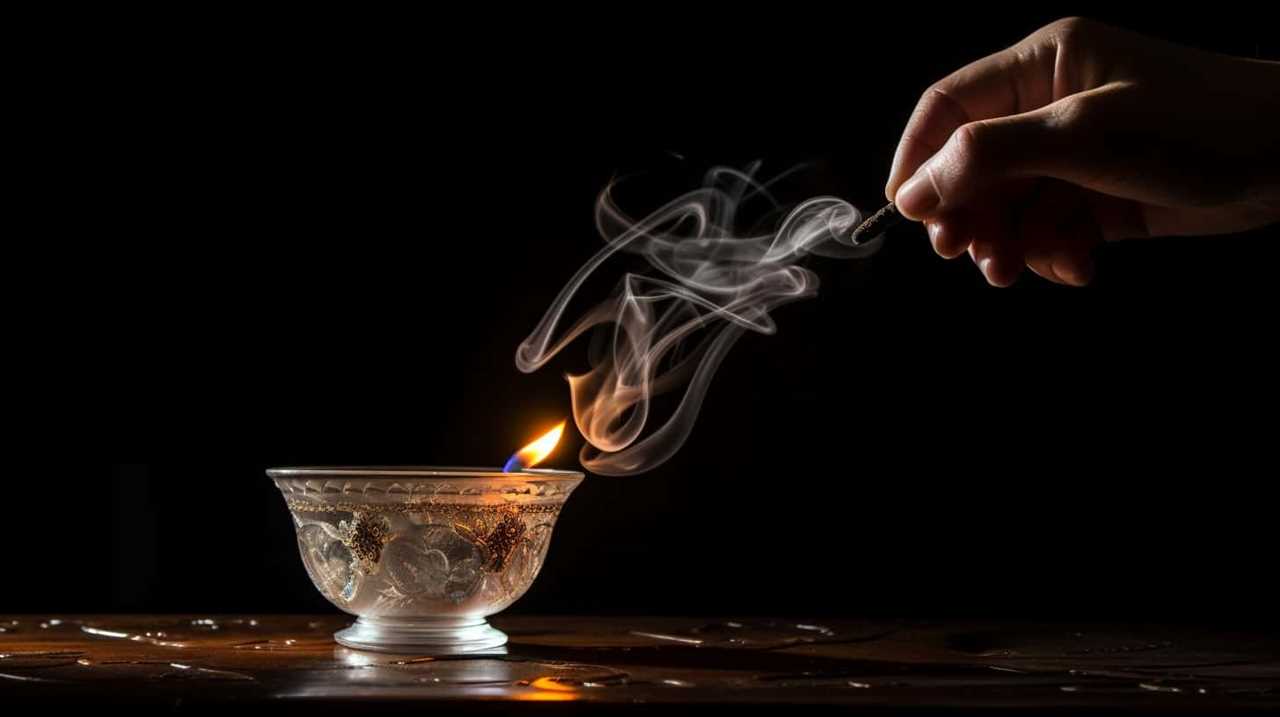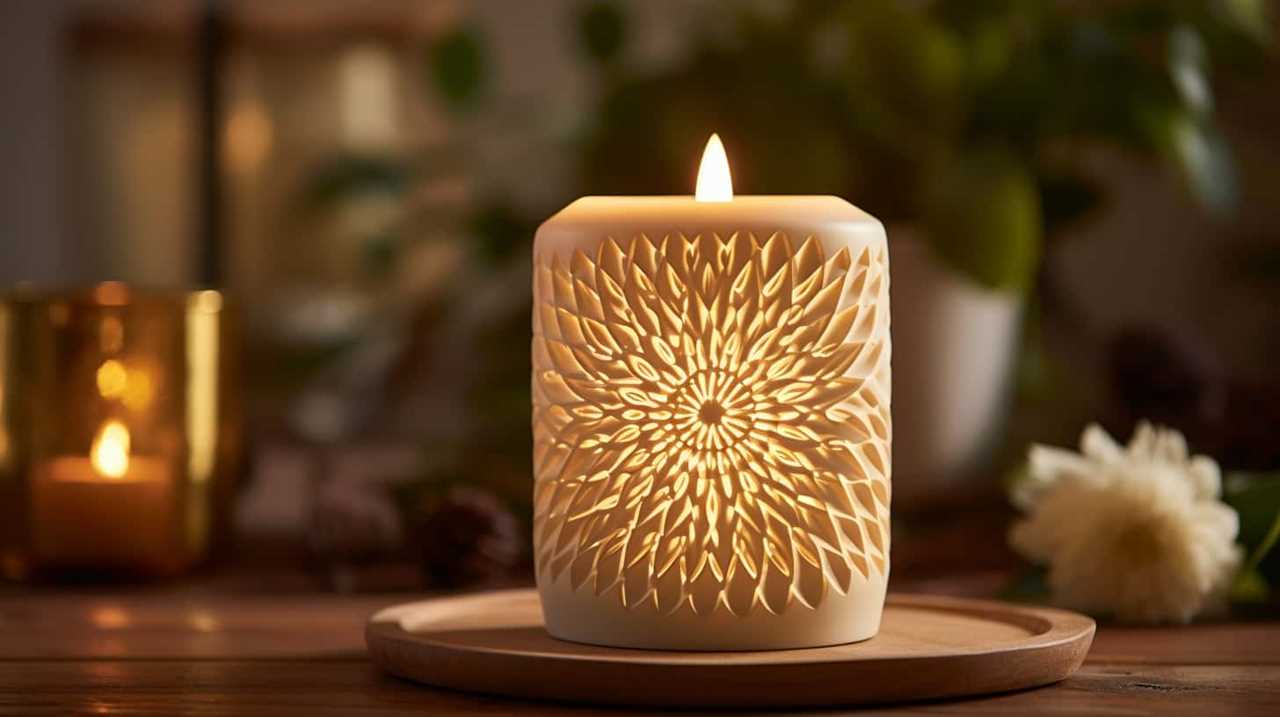Welcome, everyone, to our tutorial on how to use the powerful St. Jude candle.
Just like a guiding light in a vast dark sea, this candle can illuminate our path towards achieving our desires.
In this journey of mastery, we will uncover the steps to harness the energy of St. Jude and manifest our intentions.
With an active voice, we will set our intentions, light the candle, recite prayers or affirmations, and engage in deep reflection.

Through this process, we will cultivate gratitude and bring closure to our ritual.
So, let us embark on this transformative journey with St. Jude as our steadfast companion, guiding us towards our desired outcomes.
Key Takeaways
- Setting the intention is crucial for connecting with the divine and manifesting desires.
- Lighting the St. Jude Candle focuses energy and channels it towards goals.
- Reciting prayers or affirmations helps align intentions with divine energy.
- Meditating and reflecting on intentions helps strengthen the connection with St. Jude’s energy.
Setting the Intention
To begin, we set our intention when using the St Jude Candle. Setting the intention is a crucial step in connecting with the divine and manifesting our desires.
The St Jude Candle serves as a powerful tool to focus our energy and channel it towards our goals. When lighting the candle, take a moment to quiet the mind and visualize what you want to achieve.

Be specific and clear in your intention, as this will help the divine energy align with your desires. It’s important to trust in the process and believe that your intention will manifest.
Remember to express gratitude for the divine guidance and support throughout this journey. By setting a strong intention, you open the door for miracles to unfold and bring your desires to fruition.
Lighting the Candle
After setting our intention, we gather together as a group and light the St Jude Candle. Before lighting the candle, it’s important to ensure that the wick is trimmed to a quarter inch in order to promote an even burn and prevent excessive smoke. Candle maintenance is essential for a successful ritual.
As the flame dances atop the wick, it symbolizes the presence of St Jude and our connection to the divine. The flickering flame represents the energy and power of our intentions, guiding them towards manifestation. It’s important to observe the flame closely, as it can provide insights into the success of our prayers. A steady, strong flame indicates that our intentions are being heard and received by St Jude.

As we move forward, let’s now transition into the next section about reciting prayers or affirmations.
Reciting Prayers or Affirmations
We begin by collectively reciting our prayers or affirmations, using specific and heartfelt words of intention. This step allows us to connect with St. Jude on a deeper level and express our desires and needs.
Here are some techniques to enhance your prayer or affirmation practice:
- Chanting mantras: Incorporate powerful and meaningful mantras that resonate with you. Repeat them with devotion and sincerity.
- Visualizing intentions: Close your eyes and visualize your desires manifesting. Imagine the outcome you wish to achieve and feel the emotions associated with it.
- Using affirmations: Craft positive affirmations that align with your intentions. Repeat them with conviction and belief in their manifestation.
- Speaking from the heart: Express your prayers or affirmations with authenticity and honesty. Let your words flow naturally, reflecting your true desires.
- Adding gratitude: Express gratitude for the blessings and support already received. Thank St. Jude for his intercession and guidance in advance.
Meditating and Reflecting
As we continue our journey of using the St. Jude Candle, our next step involves meditating and reflecting on our intentions.

Guided visualization and deep breathing techniques can enhance the effectiveness of this practice. Find a quiet and comfortable space where you can be uninterrupted. Close your eyes and take a few deep breaths, allowing your body to relax and your mind to quiet.
Begin by visualizing your intention clearly in your mind’s eye. See it as if it has already manifested in your life. Hold this image in your mind and feel the emotions associated with achieving your goal. Stay in this state of visualization and emotional connection for a few minutes, allowing the energy of your intention to permeate your being.
Afterward, take a few more deep breaths and slowly open your eyes, feeling a sense of gratitude and empowerment.
Expressing Gratitude and Closing the Ritual
Once we’ve completed our meditation and reflection, it’s important to express gratitude and close the St. Jude Candle ritual. Finding closure and showing appreciation allows us to honor the process and acknowledge the power of our intentions.

Here are five ways to express gratitude and bring the ritual to a close:
- Offer a heartfelt thank you to St. Jude for his intercession and guidance.
- Write down the insights and blessings received during the ritual, allowing gratitude to flow onto the paper.
- Light a small candle as a symbol of gratitude and let it burn for a few minutes, acknowledging the energy and connection created.
- Say a closing affirmation or prayer to seal the ritual and express gratitude for the support received.
- Take a moment of silence to reflect and offer thanks for the opportunity to connect with St. Jude’s energy.
Frequently Asked Questions
How Long Does a St Jude Candle Typically Burn For?
A St. Jude candle typically burns for around 3 to 5 days, depending on the size and quality. However, it’s important to never leave a candle unattended. St. Jude candles can also serve as a reminder of hope and faith.
Can I Use a St Jude Candle for Purposes Other Than Seeking Help for Desperate Situations?
Sure! St Jude candles can be used for more than desperate situations. They hold deep symbolism and can serve as a powerful tool for meditation, reflection, and seeking guidance in any challenging circumstance.
Is It Necessary to Recite Specific Prayers or Can I Use My Own Personal Affirmations?
Using personal affirmations can be beneficial when using a St Jude candle. However, reciting specific prayers is recommended as they have been traditionally associated with invoking the intercession of St Jude.

Are There Any Specific Rituals or Practices That Should Be Followed While Meditating With a St Jude Candle?
When meditating with a St Jude candle, there are specific rituals and practices that can enhance the experience. These include setting intentions, focusing on gratitude, and invoking the energy of St Jude. These practices can deepen meditation and bring numerous benefits.
Can I Extinguish the St Jude Candle Before It Burns Out Completely?
Yes, you can extinguish the St. Jude candle before it burns out completely. However, it is important to note that burning it completely is often seen as a symbol of dedication and commitment to the saint.
Conclusion
In conclusion, using a St. Jude candle is a powerful ritual that allows us to:
- Set intentions
- Find solace
- Express gratitude
Just as the flickering flame illuminates the darkness, this practice can bring hope and healing to our lives. By:

- Lighting the candle
- Reciting prayers or affirmations
- Taking time to meditate and reflect
We can tap into the transformative energy of St. Jude and find comfort in times of struggle.









